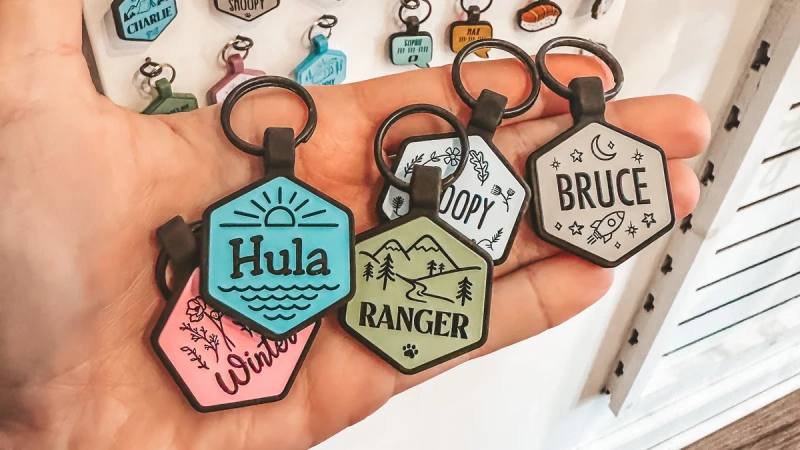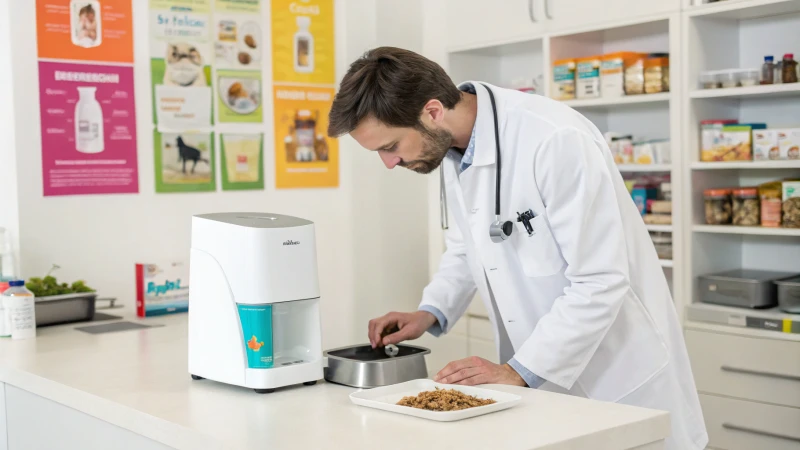
Thinking about buying an automatic feeder for your furry friend? Let’s see what the experts probably think!
Veterinarians know the good and bad sides of automatic pet feeders. They save time and control food portions. But, regular checks are very important to keep an eye on your pet’s health. A good choice may depend on these facts. Your furry friend’s well-being is very important.
As a pet owner, I know the wish for ease in busy lives. An automatic feeder looked interesting to me when I thought about it for the first time. It seemed like it might really simplify feeding times. A talk with my vet opened my eyes to both benefits and warnings. These feeders truly help keep feeding times regular and stop pets from eating too much. This is useful, especially in homes with many pets. However, careful attention is needed. My eyes must check if my pet eats well and if the feeder functions correctly. No one wants a breakdown during mealtime!
Automatic feeders improve portion control for pets.True
Veterinarians agree that automatic feeders help maintain proper portion sizes, promoting healthier eating habits in pets.
Vets recommend using automatic feeders without supervision.False
Veterinarians advise against relying solely on automatic feeders; regular monitoring of pets' health is essential.
What Are the Key Benefits of Automatic Feeders?
Do you try to manage a packed schedule while looking after your furry friend? Automatic feeders change your pet care routine into something easier and more fun. They really help.
Automatic feeders give important benefits like convenience for busy owners and precise portion control to stop overfeeding. They provide tailored feeding solutions for homes with many pets. These feeders allow owners to keep a steady feeding schedule. A regular routine is very helpful.
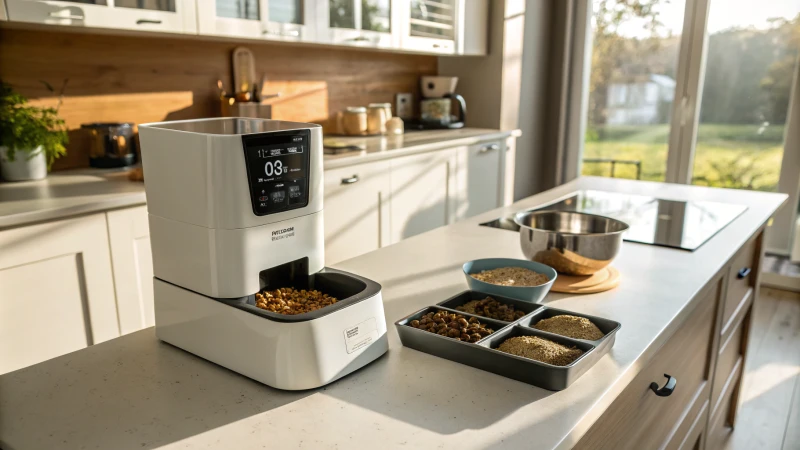
Convenience for Busy Pet Owners
Busy days fill my schedule with work and errands, and automatic feeders bring much-needed relief. Picture this: running out the door, late for a meeting, suddenly remembering that my beloved dog has not eaten. Automatic feeders remove this worry in hectic mornings. They keep my furry friend on a steady feeding schedule, which is very important for health.
When work hours change unexpectedly, my pet still receives meals at regular times. This helps growth and prevents weight problems. It feels like a little helper feeds my dog well, even when I am not present. Curious about these wonders? Check out how automatic feeders work1.
Portion Control
Managing my dog’s diet used to be tough. Automatic feeders changed this! They provide exact portions at set times, which helps keep my dog’s weight in check. Every pet owner worries about overfeeding.
| Pet Size | Recommended Portion Size | Automatic Feeder Advantage |
|---|---|---|
| Small | 1/4 cup | No overfeeding risk |
| Medium | 1/2 cup | Accurate portioning |
| Large | 1 cup | Prevents obesity |
Bye-bye, guilty feelings from overindulgence! My dog gets the right nutrition amount without me measuring it each time. Interested in good feeding practices? See pet nutrition guidelines2.
Multi-Pet Households
With several pets, my home can feel like a small zoo! Some automatic feeders shine in adjusting to different dietary needs with microchip technology. Each pet receives exactly what they need without sneaky furballs stealing food.
No more dinner-time arguments! Every pet in my house benefits from a personalized diet without stress. Managing many pets like I do? Check out feeding tips for multiple pets3.
Monitoring and Maintenance Considerations
Automatic feeders are fantastic, but human supervision remains crucial. I always observe my pets’ eating habits to spot health issues early—truly important.
I regularly check the feeder to ensure it works well. A broken feeder might cause missed meals or overeating! For maintenance advice, see automatic feeder upkeep4.
Not a Substitute for Human Interaction
Automatic feeders offer great convenience but never replace the love and attention pets need. If away for more than a few hours, I arrange someone to check on my pets—meals and love together!
Planning trips? Consider exploring pet sitting services5 to keep pets safe and happy while you’re away.
Automatic feeders improve pet care routines significantly, but knowing their uses and limits is key. With extra attention, they simplify life for us and our pets—truly.
Automatic feeders ensure pets are fed on schedule.True
They help maintain a consistent feeding routine, crucial for pet health, especially for busy owners.
Automatic feeders can completely replace human supervision.False
While they offer convenience, regular human monitoring is essential for pet health and well-being.
What Risks Should Pet Owners Be Aware Of?
As a pet owner, I really wonder about the happiness my furry friend brings. This joy also carries responsibility. Pet ownership involves risks. I learned a lot about it!
Pet owners need to know about possible dangers. Health problems like allergies and diseases that spread from animals to people are major risks. Behavior issues like aggression and anxiety also pose challenges. Environmental threats like poisonous substances and escape dangers are important too. These facts help in keeping a safe and happy life for both you and your pet. Safety is really crucial.
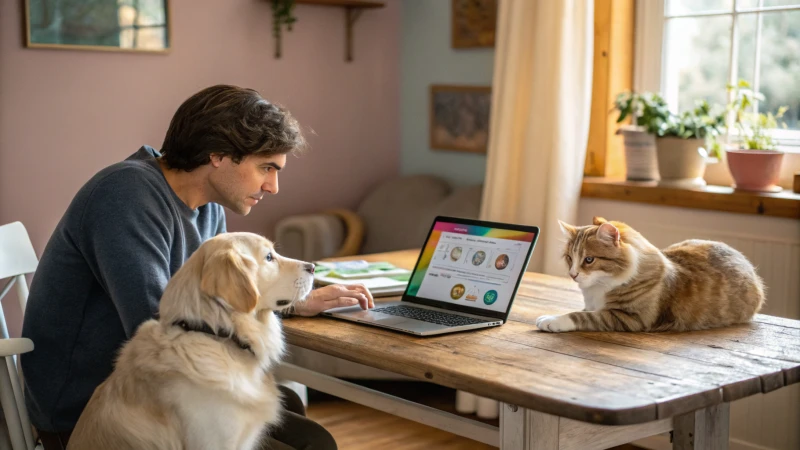
Health Risks to Think About
Owning a pet brings much joy, but it also carries health dangers. People should be aware of problems like allergies and possible injuries.
Allergies: My eyes itched and my nose ran when I hugged my cat. This taught me that allergies to pet hair, saliva, or pee happen more often than I thought. If you sneeze or itch, it’s wise to look into managing pet allergies6 effectively.
Zoonotic Diseases: Pets sometimes spread diseases to humans. This fact really surprised me. Knowing about these diseases gave me peace of mind as a pet owner. Examples include:
| Disease | Symptoms | Prevention |
|---|---|---|
| Toxoplasmosis | Flu-like symptoms | Practice good hygiene |
| Ringworm | Skin rash | Regular grooming |
| Rabies | Severe neurological symptoms | Vaccination and control of wild animals |
Research shows that educating yourself about these diseases can reduce risk. For more on preventing zoonotic diseases7, click here.
Behavioral Risks
I realized that pets need emotional care just like physical care. Socializing and training pets well can really cut down on behavior issues.
Aggression: A friend’s dog got aggressive during playdates. This scared us! Fear or poor socialization often causes pets to act this way. Proper training and socialization can help mitigate this risk. Explore training methods for aggressive pets8 for more insights.
Anxiety: My dog created chaos when I left him alone for the first time. This showed me how important it is to handle separation anxiety. Understanding this condition and how to address it is vital for your pet’s well-being. Find strategies for managing pet anxiety9 effectively.
Environmental Dangers
The environment matters a lot to pet safety. Safe spaces keep pets protected.
Toxic Substances: I found out some houseplants could hurt pets, including:
- Plants: Certain plants like lilies and azaleas can be fatal if ingested.
- Chemicals: Common cleaning supplies and antifreeze can pose severe risks.
For a comprehensive list of toxic plants and substances10, refer here.
Escape Risks: Secure fences and locked doors are very crucial! My neighbor’s dog got lost because a gate was left open. Ensure your yard is secure and consider microchipping your pet as an additional safety measure. Learn more about the importance of pet identification11.
Pet dander can trigger allergies in sensitive individuals.True
Many people develop allergies to pet dander, leading to symptoms like sneezing and asthma.
Zoonotic diseases can be transmitted from pets to humans.True
Pets can carry diseases like rabies and toxoplasmosis that are transmissible to humans.
How Do Automatic Feeders Compare to Manual Feeding?
Deciding whether to use automatic feeders or feed manually might seem confusing. It’s true – this choice matters for your pet’s well-being. Pets’ health and joy are linked to how they eat. Let’s look at the details closely!
Automatic feeders provide ease and control over portions. These are perfect for busy people like me. Manual feeding, however, promotes personal interaction and offers more flexibility. Manual feeding takes a lot of time. Each method has benefits and risks. They are worth considering for your pet’s health.
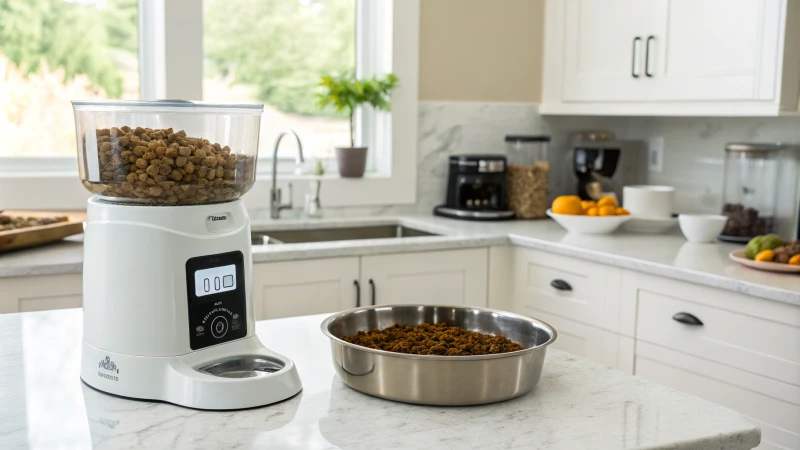
Benefits of Automatic Feeders
Automatic feeders changed my life, especially on busy days. Here are some major advantages:
-
Convenience: The feeder dispenses food at the same time daily. This routine makes my dog happy and helps avoid obesity from irregular eating. A steady schedule is really important.
-
Portion Control: I program the exact food amount for each meal. This is vital to keep my dog energized without overeating. Knowing he gets the right calories really gives me peace of mind.
-
Multi-Pet Households: With multiple pets, some feeders only allow the right pet to eat. This stops sneaky pets from stealing food, which is essential in homes with different diets.
Considerations and Risks
Automatic feeders do have some issues. Here is what I discovered:
| Risk | Description | Mitigation Strategy |
|---|---|---|
| Monitoring Required | Regular supervision is necessary to ensure pets eat their food and to monitor health. | Check feeding logs and observe behavior. |
| Malfunctions | Mechanical failures can lead to missed meals or overfeeding if not regularly tested. | Test the feeder frequently for reliability. |
| Not for Long Absences | These feeders can’t replace the need for a pet sitter during extended periods away. | Arrange for a trusted pet sitter. |
Manual Feeding Advantages
On the other hand, feeding by hand feels special:
-
Personal Interaction: Feeding time creates a strong bond as I nourish my pet and see how he feels every day; it’s very comforting.
-
Flexibility: I change portions and timing based on my dog’s needs, like after playtime, which is important for special diets too.
-
Health Monitoring: I notice changes in eating or health during feeding, allowing quick action if something seems wrong.
Manual Feeding Disadvantages
But there are negatives:
- Time-Consuming: Manual feeding needs dedication; some days I’m overwhelmed and it’s hard to maintain a routine.
- Inconsistent Portions: Busy days lead to forgetting exact measurements, causing overfeeding or underfeeding.
- Missed Feedings: Losing track of time or last-minute events means my dog might miss a meal.
In conclusion, both automatic and manual feeding have unique perks and challenges to think about. It usually depends on my daily life and my dog’s needs. Whether you like convenience or treasure bonding during meals, it’s about what works best for you and your pet.
Automatic feeders ensure pets are fed at consistent times.True
Automatic feeders provide a reliable schedule, preventing irregular eating patterns that can lead to obesity and support healthy growth.
Manual feeding allows for better monitoring of pet health.True
Feeding pets manually enables owners to observe changes in eating habits, facilitating quicker responses to health issues.
What Features Should You Look for in an Automatic Feeder?
Are you thinking about buying a device to feed your furry friend automatically? Discover the important features that turn feeding time into a simple task. These devices keep pets happy and healthy!
Choose an automatic feeder with very convenient features. Programmable schedules help manage feeding times. Portion control supports healthy eating. Multi-pet compatibility allows use for different pets. Monitoring alerts provide updates. Safety materials protect pets. Easy cleaning simplifies maintenance.
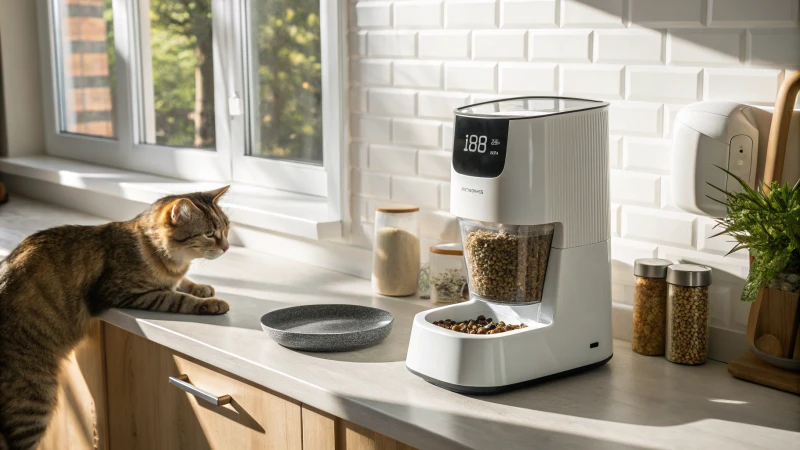
Convenience Features
Choosing the right automatic feeder really means thinking about convenience. When I had to balance work and caring for Max, my little pup, life got busy. I often wished for an easy way to feed him on time. Then I discovered the automatic feeder! It changed everything, especially with its programmable feeding schedules.
Set different meal times throughout the day. Know that Max always gets his meals, even if I’m busy or out. Some feeders store food for a whole week. This really helps those of us with unpredictable schedules. Check out different programmable feeders12 that suit your pet’s diet.
Portion Control
Portion control also matters a lot. I learned how overfeeding can harm health, particularly for pets like Max who gain weight easily. Automatic feeders let me set exact food amounts for each meal. It’s a relief knowing Max only gets what he needs – no extra snacks when I’m not watching!
Look for feeders where you can easily adjust portion sizes. They are lifesavers. For those interested in customizable options, discover feeders with various portion settings here13.
| Feeder Model | Portion Control | Maximum Meals per Day | Food Capacity |
|---|---|---|---|
| PetSafe Healthy Pet | Adjustable | 12 | 24 cups |
| Cat Mate C3000 | Fixed | 3 | 3.5 kg |
| WOpet Smart Feeder | Customizable | 4 | 20 cups |
Multi-Pet Compatibility
With several pets, multi-pet compatibility becomes crucial. Max once sneaked into his sister Bella’s food. Very sneaky! Feeders for multiple pets are a big help. Microchip feeders are fantastic because they allow just the right pet to eat their meal, avoiding any food drama.
These smart gadgets recognize pets through their microchip or collar tag. If this situation sounds familiar, explore microchip feeder options14 that fit your needs.
Monitoring and Alerts
Even with an automatic feeder, watching my pets’ eating habits stays important. I always look for smart technology in feeders. Phone alerts when meals are given or issues occur provide peace of mind. It’s like a mini security system for pet meals.
This feature really helps me monitor their eating and catch any new habits early. For feeders with monitoring features, look at smart feeder options here15.
Safety Features
Safety is a priority for me. Once, I bought a feeder with toxic plastic without checking. Now, I pick feeders made from strong, non-toxic materials. Features like anti-jam technology and backup battery systems keep feeding schedules smooth, even if power fails.
Always read user reviews about safety features before buying to guarantee your pet’s safety. Find out more about safe automatic feeders16 that keep your furry friends healthy.
Maintenance and Cleaning
Easy maintenance is essential. Cleaning an automatic feeder should be simple – trust me, this is vital! I’ve had messy experiences with food in tough spots. Now, I like models that come apart easily and can go in the dishwasher. Some even have removable bowls for effortless cleaning.
Before buying, look at reviews on how easy models are to maintain; this greatly affects your long-term happiness. For tips on feeder cleaning, explore this helpful resource.
In summary, when picking an automatic feeder, ponder convenience features, portion control, multi-pet compatibility, monitoring options, safety measures and maintenance ease. Each feature plays a crucial role in selecting the right feeder for your cherished pet’s needs.
Automatic feeders can store food for up to a week.True
Many automatic feeders are designed to hold enough food for several days, making them ideal for busy pet owners.
All automatic feeders are safe for pets.False
Not all automatic feeders are made from non-toxic materials; safety certifications should be checked before purchase.
Conclusion
Veterinarians recognize the benefits of automatic feeders for convenience and portion control but stress the importance of regular monitoring for pet health.
-
This link will provide you with detailed insights on how automatic feeders can enhance your pet care routine, making life easier for both you and your furry friends. ↩
-
Explore how portion control through automatic feeders contributes to better pet health and nutrition management. ↩
-
Learn effective strategies for managing multiple pets’ feeding needs using automatic feeders. ↩
-
Find out how to maintain and monitor automatic feeders effectively to ensure they function properly over time. ↩
-
Discover the importance of human interaction alongside automated feeding systems for your pets’ overall well-being. ↩
-
Explore detailed insights on health risks associated with pet ownership to keep your family safe. ↩
-
Discover how to prevent zoonotic diseases from affecting your family. ↩
-
Learn effective training techniques to minimize behavioral risks in pets. ↩
-
Get tips on managing separation anxiety in pets effectively. ↩
-
Find out how to create a safe home environment for your pets. ↩
-
Understand the significance of pet identification to ensure their safety. ↩
-
Explore comprehensive reviews on various automatic feeders to find the one that best fits your pet’s needs and lifestyle. ↩
-
Learn about the latest technologies in smart automatic feeders that offer enhanced monitoring and convenience. ↩
-
Find out which automatic feeders are most recommended by veterinarians for their reliability and safety features. ↩
-
Discover cleaning tips and maintenance advice for keeping your automatic feeder in top condition. ↩
-
Check the best practices for training your pet to use an automatic feeder effectively. ↩


